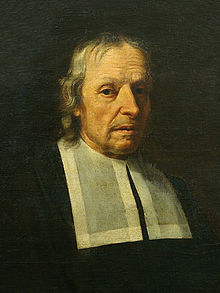Marcello Malpighi
|
Doctor of Medicine Marcello Malpighi |
|
|---|---|

Marcello Malpighi, a lifetime portrait by Carlo Cignani
|
|
| Born |
10 March 1628 Bologna, Papal States |
| Died | 29 November 1694 (aged 66) Rome, Papal States |
| Nationality | Italian |
| Fields |
Anatomy Histology, Physiology, Embryology, Practical Medicine |
| Institutions |
University of Bologna University of Pisa University of Messina |
| Alma mater | University of Bologna |
| Doctoral advisor | Giovanni Alfonso Borelli |
| Doctoral students | Antonio Maria Valsalva |
| Known for | Important contributions on biological fields |
Marcello Malpighi (10 March 1628 – 29 November 1694) was an Italian biologist and physician, who is referred to as the "Father of microscopical anatomy, histology, physiology and embryology". Malpighi's name bears to several physiological features related to the biological excretory system, such as the Malpighian corpuscles and Malpighian pyramids of the kidneys and the Malpighian tubule system of insects. The splenic lymphoid nodules are often called the "Malpighian bodies of the spleen" or Malpighian corpuscles. The botanical family Malpighiaceae is also named after him. He was the first person to see capillaries in animals, and he discovered the link between arteries and veins that had eluded William Harvey. Malpighi was one of the earliest people to observe red blood cells under a microscope, after Jan Swammerdam. His treatise De polypo cordis (1666) was important for understanding blood composition, as well as how blood clots. In it, Malpighi described how the form of a blood clot differed in the right against the left sides of the heart.
The use of the microscope enabled Malpighi to discover that invertebrates do not use lungs to breathe, but small holes in their skin called tracheae. Malpighi also studied the anatomy of the brain and concluded this organ is a gland. In terms of modern endocrinology, this deduction is correct because the hypothalamus of the brain has long been recognized for its hormone-secreting capacity.
Because Malpighi had a wide knowledge of both plants and animals, he made contributions to the scientific study of both. The Royal Society of London published two volumes of his botanical and zoological works in 1675 and 1679. Another edition followed in 1687, and a supplementary volume in 1697. In his autobiography, Malpighi speaks of his Anatome Plantarum, decorated with the engravings of Robert White, as "the most elegant format in the whole literate world."
...
Wikipedia
